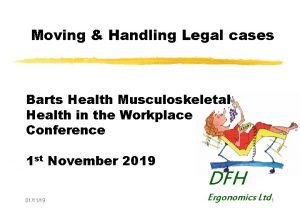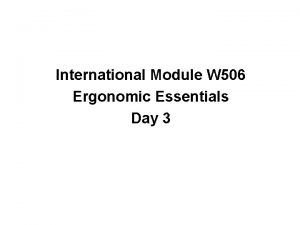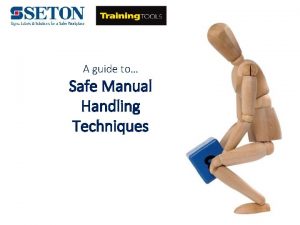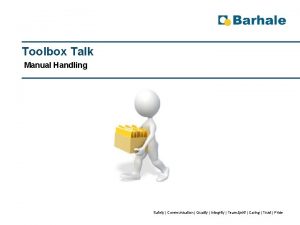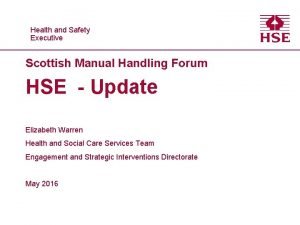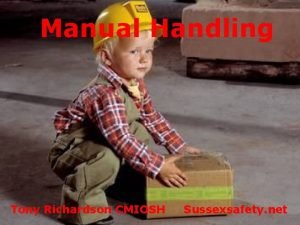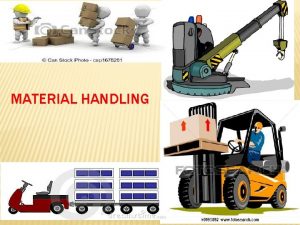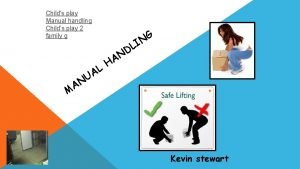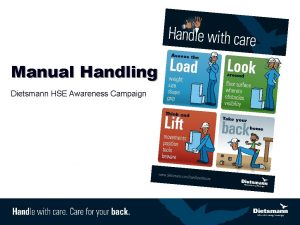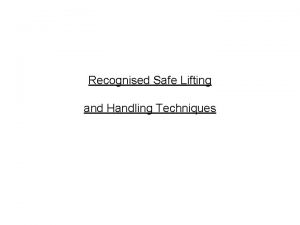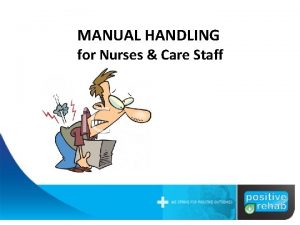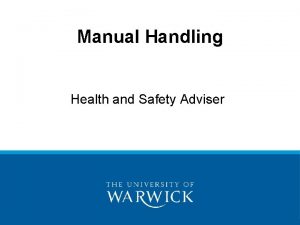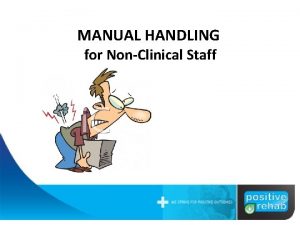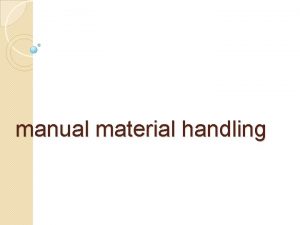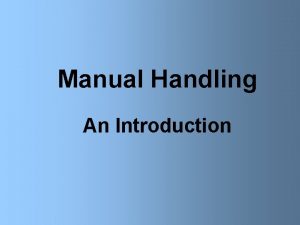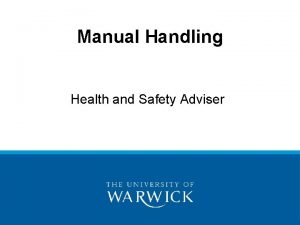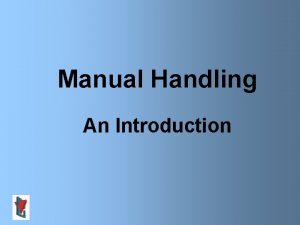Manual handling q What is manual handling q












- Slides: 12

Manual handling q. What is manual handling q. Manual handling activities q. Possible injuries when handling q. Ways to reduce risk q. Manual handling images q. What is lifting q. Manual lifting q. Lifting techniques q. Manual lifting hazards q. Lifting equipment

WHAT IS MANUAL HANDLING • Any activity which require the use of force by a person • Any transporting or supporting of a load by bodily force or hand. • The supporting/moving of a person, animal or object

Manual Handling Activities • Pushing • Pulling • Lifting • Putting down • Carrying • Moving • Stacking shelves • Operating machines • Packing boxes

POSSIBLE INJURIES WHEN HANDLING • Sprains • Strains • Neck injury • Back injury • Cuts • Bruises • Broken bones • Spinal • Nerve • Joints

Ways to reduce risk • Lighten load • Reduce bending, twisting and reaching movements • Practice correct manual handling techniques • Use team lifting when required • Use mechanical assistance (workbench, seating, adjustable heights) • Read operational manual before using equipment/machines • Report any defects observed on machinery when observed • Avoid slippery and uneven floors • Take rest breaks • Warm up muscles before working to prevent strain, etc.

Manual handling images

What is lifting • To raise to a higher position or level • Pick up and move to a different position • Lifting or lowering of a load • A lifting operation performed manually or with lifting equipment

Manual lifting • Keep the load close to the body as long as possible when lifting • Keep the heaviest side of the load next to the body • Avoid twisting the back or leaning sideways • Lift with legs not back • Lift no more than 25 kg individually • Keep your back straight and knees bent when attempting to lift load • Keep back and neck straight when carrying load • Ensure load is properly positioned to lift • Practice proper lifting technique to avoid injury

Lifting techniques

Manual lifting hazards • Load is too heavy • Load is too large • Load is unbalanced, unstable or difficult to grasp • Awkward posture or movement • High rate of work with insufficient recovery periods • Insufficient working space • Uneven floors • Lack of experience • Insufficient lighting, etc. • Unsuitable working conditions (temperature, humidity, etc. )

Lifting equipment • Any work equipment for lifting or lowering loads • Hoist • Crane • Lift • Jack • Passenger lifting/lowering equipment • Crawler • Lifting accessories

references • https: //www. google. com/search? q=images+of+lifting+equip ment&sxsrf • https: //www. hse. gov. uk/work-equipment-machinery/liftequipment. htm • https: //oshwiki. eu/wiki/Lifting_operations_and_lifting_equi pment#: ~: text • https: //www. shutterstock. com/image-vector/vectorillustration-manual-handling-loads-worker-1008730924 • https: //employsure. com. au/guides/workplace-health-andsafety/manual-handling/
 Litee manual handling
Litee manual handling W 506
W 506 Manual handling positions
Manual handling positions Manual handling tool box talk
Manual handling tool box talk Moving and handling competency assessment template
Moving and handling competency assessment template Scottish manual handling forum
Scottish manual handling forum Manual handling pictures
Manual handling pictures Ahm 560
Ahm 560 Client handling task
Client handling task Introduction of material handling
Introduction of material handling Child's play manual handling
Child's play manual handling Manual handling campaign
Manual handling campaign Load kinetic lift
Load kinetic lift
